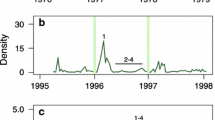Summary
When a population budget must be obtained from censuses based on replicated, sacrificed cultures, it is difficult to obtain estimates of transition probabilities and of the errors of such estimates, because there is no logical basis for pairing successive census counts. In a study of this nature estimating a population budget of immature stages of the housefly, the problem was solved by a randomization treatment of the original census results obtained at two densities. One hundred randomly generated census matrices over all census times for each density were smoothed to remove the effects of sampling error and a population budget constructed according to defined rules. Transition probabilities computed from the population budget were plotted on triangular coordinate paper and mean probabilities, 95% confidence regions for these means, and 95% equal frequency ellipses computed. All computations and the graphing of the results were carried out on a digital computer. The computer program, available from the authors, is written in FORTRAN IV and could be easily modified for similar studies.
Similar content being viewed by others
References
Bryant, E.H. andR.R. Sokal (1967) The fate of immature housefly populations at low and high densities.Res. Popul. Ecol.,9: 19–44.
Author information
Authors and Affiliations
Additional information
Contribution No. 1364 from the Department of Entomology, The University of Kansas.
This study has been supported by the Medical Research and Development Command of the Office of the Surgeon General of the Army under contract No. DA-49-007-MD-738, U.S.A. and by a Public Health research career program award (No. 3-K3-GM-22, 021-01S1) from the National Institute of General Medical Sciences, U.S.A. to RobertR. Sokal. It was carried out during the tenure of a National Science Foundation predoctoral fellowship by EdwinH. Bryant.
The authors appreciate the help of Dr.F.J. Rohlf with computational aspects.
Rights and permissions
About this article
Cite this article
Sokal, R.R., Bryant, E.H. Computing a population budget from sequentially sacrificed, replicated cultures. Res Popul Ecol 9, 10–18 (1967). https://doi.org/10.1007/BF02521393
Issue Date:
DOI: https://doi.org/10.1007/BF02521393




